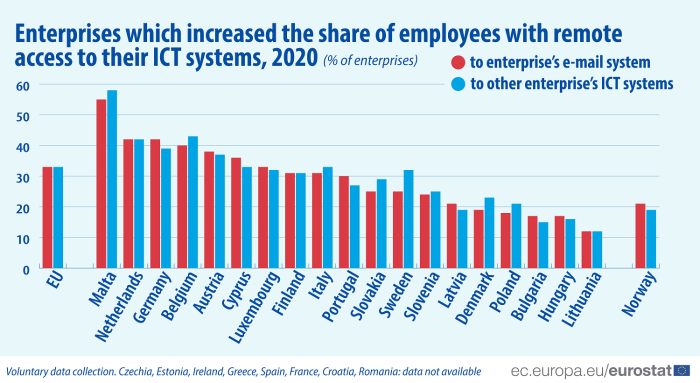Impact of COVID-19 on the use of ICT in enterprises
Data extracted in March 2022
No planned article update
Highlights
In 2020, 33% of EU enterprises increased the share of staff having remote access to company’s e-mail or other ICT system.
During 2020, 91% of EU enterprises that increased remote access to their e-mail systems for their employees, did so at least partly due to COVID-19.
During 2020, 94% of EU enterprises that increased remote access to their ICT systems for their employees, did so at least partly due to COVID-19.
In 2020, 50% of EU enterprises increased the number of remote meetings, of which 97% did so at least partly due to COVID-19.
For decades, the adoption of digital technologies by enterprises has been transforming the way they conduct their business. In 2020, the COVID-19 pandemic caused restrictions in mobility, which forced many enterprises to increase, or even fully shift, towards digital technologies to be able to maintain their activities. These exceptional circumstances have, more than ever, emphasised the potential that digital technologies entail for improving the economic resilience of businesses. Enabling access to an enterprise's resources from outside of the enterprise's premises, i.e. remote access to e-mail or to other ICT systems of the enterprises, created a possibility for employees to continue performing their tasks and thus sustain the enterprise's activity. The use of internet communication software allowed also internal business communication within the enterprises, as well as with the outside world.
This article presents the results of a special module of the 2021 survey on ICT usage and e-commerce in enterprises. The module was introduced to measure the impact of the restrictive measures put in place to combat the COVID-19 pandemic on the use of digital technologies by enterprises. It was introduced on a voluntary basis and 19 EU Member States included it at least partially in their national survey on ICT usage and e-commerce in enterprises. The presented EU aggregates are based on the results of those Member States.
Full article
Remote access to enterprise resources and remote meetings
During 2020, 33 % of EU enterprises increased the share of persons employed having remote access to the e-mail system of the enterprise. The same share of EU enterprises (33 %) increased the proportion of staff having remote access to other ICT systems of the enterprise. Malta registered the highest share of enterprises that increased the percentage of staff having remote access to the e-mail (55 %) or remote access to other ICT systems of the enterprise (58 %), followed by the Netherlands (42 % for both), Germany (42 % and 39 % respectively) and Belgium (40 % and 43 % respectively). The lowest share of enterprises that increased the remote access to their e-mail (12 %) or other ICT systems (12 %) for their employees was recorded in Lithuania. Half of the EU enterprises increased the number of remote meetings held over the internet. The percentage of enterprises that increased the number of meetings conducted online was highest in Finland (79 %), Malta (76 %), Sweden (71 %), the Netherlands (70 %), Denmark and Belgium (both 68 %). The lowest shares of such enterprises were registered in Latvia (33 %), Poland (29 %) and Bulgaria (23 %) (Figure 1).
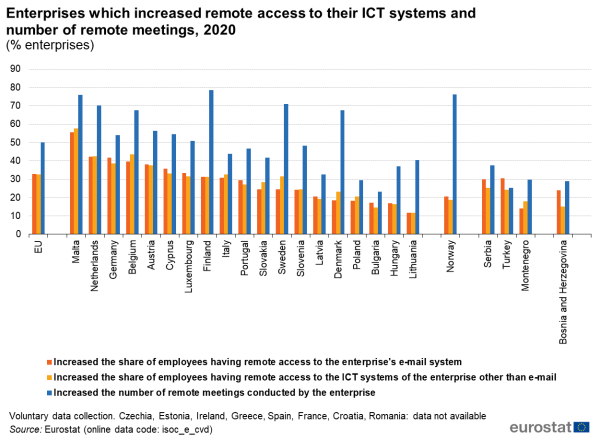
(% of enterprises)
Source: Eurostat (isoc_e_cvd)
The increase in remote access to an enterprise's ICT resources or in the number of meetings conducted online depends, of course, on the initial share of enterprises already utilising those resources, but also largely on the type of economic activity of the enterprise. More than half of EU enterprises in professional, scientific and technical activities increased remote access to the e-mail system (55 %), followed by enterprises active in information and communication (48 %). The share of enterprises increasing remote access to their e-mail system was lowest among enterprises in construction (24 %) and retail trade activities (22 %). The proportion of enterprises increasing remote access to other ICT systems for their staff was similar, with the highest in professional, scientific and technical activities, and in information and communication (both 56 %), and the lowest in construction (23 %) and retail trade activities (20 %). The proportion of enterprises that increased the number of meetings conducted remotely during 2020 was highest in information and communication activities (90 %), followed by professional, scientific and technical activities (81 %). The lowest shares of businesses that increased the number of remote meetings were in accommodation activities (40 %), transport and storage (40 %), construction (37 %) and retail trade (36 %) (Figure 2).
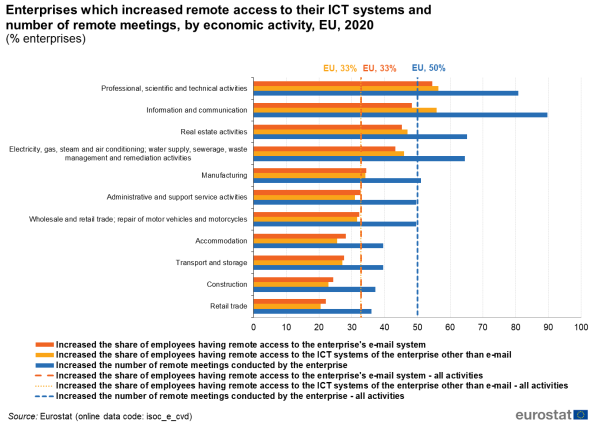
(% of enterprises)
Source: Eurostat (isoc_e_cvd)
The increase in remote access to an enterprise's ICT resources or in the number of meetings conducted online varied slightly depending on the size of the enterprise. The highest percentage of enterprises that increased the share of employees having remote access to its e-mail system (69 %) or other ICT system (76 %) was among large enterprises. In contrast, less than one third of small enterprises increased the share of employees who had remote access to the enterprise’s e-mail system (28 %) or other ICT systems (27 %).
Similarly, the percentage of enterprises that increased the number of remote meetings conducted online was highest among large enterprises (93 %), compared with medium-sized enterprises (75 %) and small enterprises (44 %) (Figure 3).
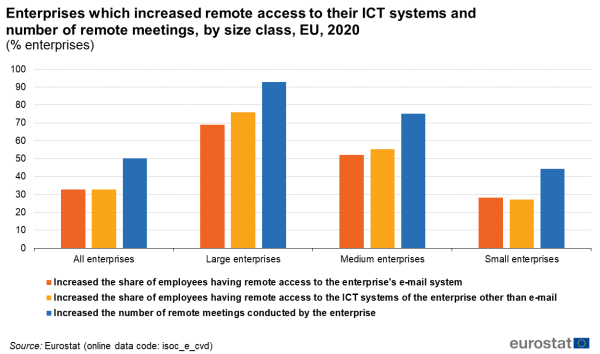
(% of enterprises)
Source: Eurostat (isoc_e_cvd)
Impact of COVID-19 pandemic on remote access to enterprise resources and remote meetings
Of the enterprises in the EU that increased remote access to the e-mail system for their employees during 2020, 91 % did so at least partly due to the COVID-19 pandemic, with 39 % declaring it was fully because of the pandemic. The degree to which the businesses giving remote access to a bigger share of employees was caused by the pandemic, varied among the Member States. In Lithuania, 100 % of enterprises at least partly explained the increased remote access to e-mail by the pandemic, followed by Cyprus (99 %), Austria and Slovakia (both 97 %) and Italy (96 %). In Poland, Austria and Lithuania, more than half of the enterprises (i.e. 55 %, 54 % and 52 % respectively) that increased the remote access to their e-mail systems, did so fully due to the COVID-19 pandemic. In contrast, in Hungary only 65 % of enterprises claimed that the increase in remote access to their e-mail system for staff was at least partly caused by the pandemic (Figure 4).
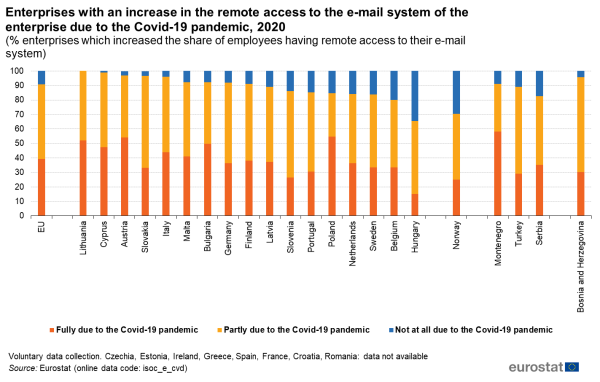
(% enterprises which increased the share of employees having remote access to their e-mail system)
Source: Eurostat (isoc_e_cvd)
While the percentage of enterprises that increased the remote access to the e-mail system for their employees during 2020 varied quite significantly depending on the type of activity (Figure 2), the share of those enterprises explaining the increase at least to some degree by the COVID-19 pandemic were more homogenous, varying between 84 % of enterprises active in the construction sector and 94 % in accommodation activities (Figure 5).
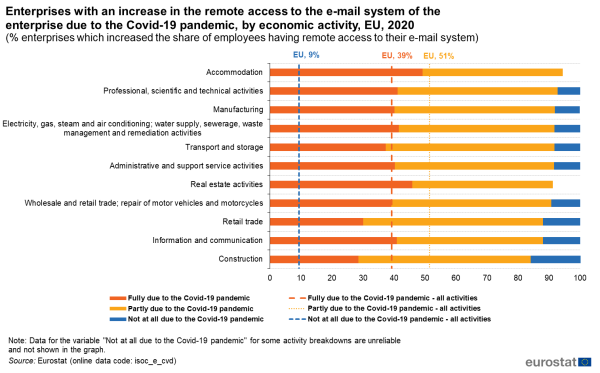
(% enterprises which increased the share of employees having remote access to their e-mail system)
Source: Eurostat (isoc_e_cvd)
The share of enterprises indicating the COVID-19 pandemic as at least a partial reason for increasing the percentage of employees who had remote access to the enterprise’s e-mail system was at a similar level among enterprises of different size classes, varying from 90 % among small enterprises to 93 % among the large ones. The share of enterprises explaining those increases fully by the pandemic was highest among large enterprises (43 %), while the share of enterprises explaining those increases only partly by the pandemic was highest among small enterprises (52 %) (Figure 6).
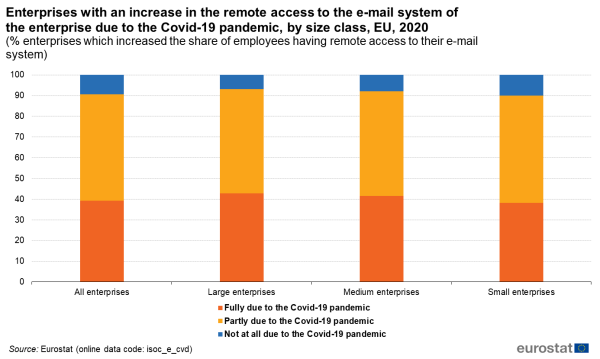
(% enterprises which increased the share of employees having remote access to their e-mail system)
Source: Eurostat (isoc_e_cvd)
Among the EU enterprises that increased remote access for their employees to ICT systems other than e-mail during 2020, 94 % reported it being at least to some extent due to the COVID-19 pandemic. The highest shares of enterprises explaining the increase in remote access to other ICT systems at least partly due to the pandemic, were recorded in Lithuania (100 %), Cyprus (99 %), Austria (98 %) and Italy (98 %), and the lowest in Hungary (71 %) (Figure 7).
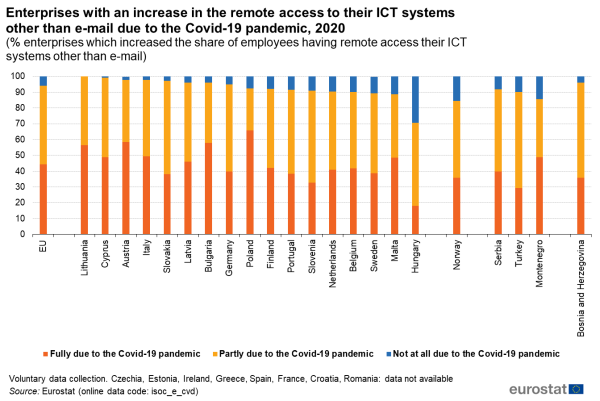
(% enterprises which increased the share of employees having remote access their ICT systems other than e-mail)
Source: Eurostat (isoc_e_cvd)
Similarly as in the case of increased remote access to an enterprise's e-mail system, for the majority of businesses that increased remote access to other ICT systems of the enterprise, this was caused at least partly by the COVID-19 pandemic, regardless of the type of activity. The highest share of enterprises that explained the increase in the remote access to their ICT systems at least partly by the pandemic was among businesses active in electricity, gas, steam and air conditioning; water supply, sewerage, waste management and remediation activities (96 %). Although only 6 percentage points lower, the smallest percentage of enterprises that at least to some degree explained the increase in remote access to their ICT systems by the pandemic, was reported by enterprises from the construction sector (90 %) (Figure 8).
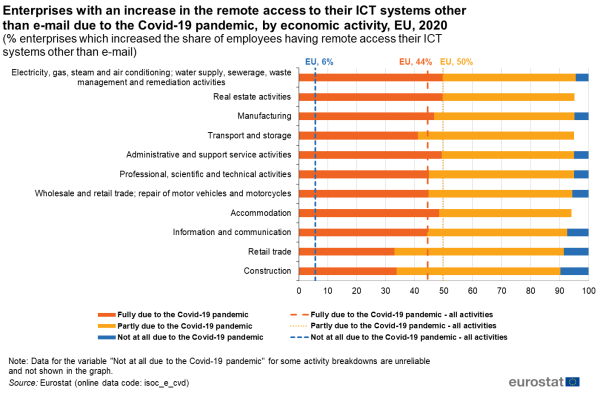
(% enterprises which increased the share of employees having remote access their ICT systems other than e-mail)
Source: Eurostat (isoc_e_cvd)
The percentage of enterprises that explained their increased share of employees who had remote access to other ICT systems of the enterprise by the COVID-19 pandemic, varied slightly among enterprises of different size classes. The majority of enterprises considered the pandemic to be at least the partial cause for those increases, varying from 93 % among small enterprises to 97 % among large ones. Around 50 % of large enterprises considered the increase in remote access to other ICT systems as being fully due to the pandemic, compared with 48 % among medium-sized enterprises and 43 % among the small ones (Figure 9).

(% enterprises which increased the share of employees having remote access their ICT systems other than e-mail)
Source: Eurostat (isoc_e_cvd)alt= a vertical stacked bar chart showing the enterprises with an increase in the remote access to their ICT systems other than e-mail due to the COVID-19 pandemic, by size class, in the EU in the year 2020.
Around 97 % of enterprises in the EU that increased the number of remote meetings during 2020, reported the change being caused by the COVID-19 pandemic. The percentage of enterprises explaining the increase in the number of meetings conducted remotely at least partly by the pandemic, varied among the Member States less than in the case of remote access to e-mail or other ICT systems. The lowest shares, though still very high, were recorded in Hungary (95 %) and Germany (96 %). The shares of enterprises that increased the number of meetings conducted online fully due to the pandemic were highest in Poland and Austria, reaching 78 % and 77 % respectively (Figure 10).
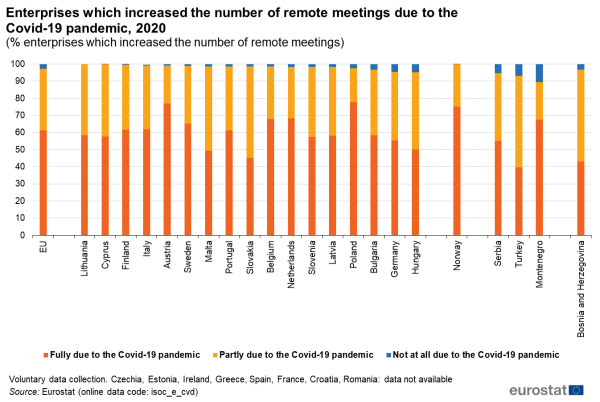
(% enterprises which increased the number of remote meetings)
Source: Eurostat (isoc_e_cvd)
Even though there were quite significant disparities among different economic activities in the percentage of enterprises that increased the number of meetings conducted remotely (Figure 2) during 2020, the shares of those enterprises explaining the increases at least partly by the COVID-19 pandemic were rather homogenous. They varied between 96 % of enterprises active in retail trade, construction and accommodation sectors and 99 % in electricity, gas, steam and air conditioning; water supply, sewerage, waste management and remediation activities (Figure 11).
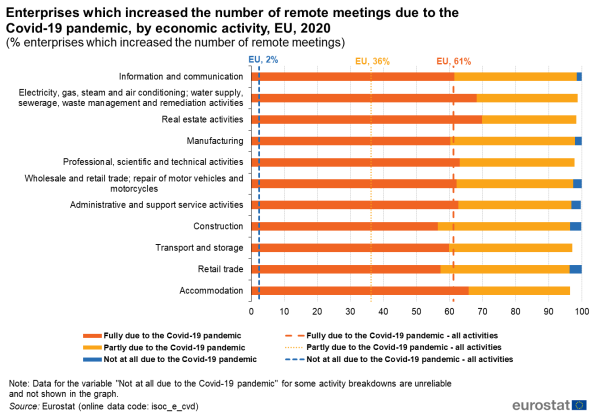
(% enterprises which increased the number of remote meetings)
Source: Eurostat (isoc_e_cvd)
Similarly, the share of enterprises that explained the increase in the number of meetings conducted remotely during 2020 at least partly by the COVID-19 pandemic, did not differ significantly among enterprises of different size classes. Almost all large and medium enterprises (99 % both) and 97 % of small enterprises reported that those increases were at least to some extent caused by the pandemic. Around 65 % of both large and medium-sized enterprises explained the increase in the number of meetings conducted remotely fully by the COVID-19 pandemic, while this share was 5 percentage points lower among small enterprises (Figure 12).
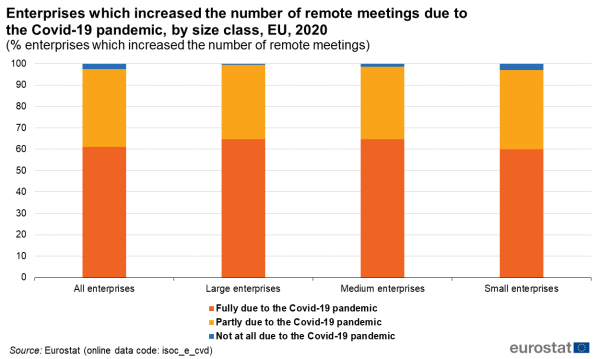
(% enterprises which increased the number of remote meetings)
Source: Eurostat (isoc_e_cvd)
Source data for tables and graphs
Data sources
Data presented in this article are based on the results of the 2021 survey on 'ICT usage and e-commerce in enterprises'. Statistics were obtained from enterprise surveys conducted by National Statistical Authorities in the first months of each year. The surveys' reference period is the current situation of the survey period or for questions on e-commerce and on COVID-19 the preceding calendar year.
In 2021, 148 000 of the 1.5 million enterprises in the EU were surveyed. Of the 1.5 million enterprises, approximately 83 % were small enterprises (10-49 employees and self-employed persons), 14 % medium (50-249 employees and self-employed persons) and 3 % large (250 or more employees and self-employed persons).
The observation statistical unit is the enterprise, as defined in the Regulation (EC) No 696/1993 of 15 March 1993. The survey covered enterprises with at least 10 employees and self-employed persons. Economic activities correspond to the classification NACE Revision 2. The sectors covered are manufacturing, electricity, gas and steam, water supply, construction, wholesale and retail trades, repair of motor vehicles and motorcycles, transportation and storage, accommodation and food service activities, information and communication, real estate, professional, scientific and technical activities, administrative and support activities and repair of computers and communication equipment. Whenever a reference is made in this article to “employees”, it refers to employees and self-employed persons
Source data shown as ':' refer to data that are unavailable, unreliable, confidential or not applicable. Unreliable data are included in the calculation of European aggregates. Data presented in this article may differ from the data in the database on account of updates made after the data extractions used for this article. Data in the database are organised according to the survey year.
Context
Digitalisation and automation can generate new business opportunities through the development of new production processes, new products and new markets. Indeed, the impact of information and communication technologies within the workplace has generally resulted in increased productivity and efficiency, as well as a range of possibilities for more flexible working practices. COVID-19 had an impact on the adoption and the use of digital technologies as it required changes in the way businesses operate.
Digital transformation is high on the European policy agenda, with making Europe fit for the digital age and empowering its citizens and businesses with a new generation of technologies being one of the main political priorities of the European Commission for the coming years. In 2021, the Digital Compass for the EU's Digital Decade (COM(2021)118 final), set the EU’s digital targets for 2030, evolving around four cardinal points: skills, digital transformation of businesses, secure and sustainable digital infrastructures, and digitalization of public services.
Direct access to
- Cloud computing - statistics on the use by enterprises
- ICT specialists - statistics on hard-to-fill vacancies in enterprises
- E-commerce statistics
- E-business integration
- ICT security in enterprises
- Social media - statistics on the use by enterprises
- Digital economy and society statistics - enterprises
Main tables
Database
- ICT usage in enterprises (isoc_e)
- Covid-19 Impact on ICT usage (isoc_e_cvd)
Legislation
- Regulation (EC) No 808/2004 of 21 April 2004 concerning Community statistics on the information society
- Summaries of EU legislation: Statistics on the information society
- Regulation (EC) No 960/2008 of 30 September 2008 implementing Regulation (EC) No 808/2004 concerning Community statistics on the information society
- Regulation (EC) No 1023/2009 of 29 October 2009 implementing Regulation (EC) No 808/2004 concerning Community statistics on the information society
- Regulation (EU) No 821/2010 of 17 September 2010 implementing Regulation (EC) No 808/2004 concerning Community statistics on the information society
- Regulation (EU) No 937/2011 of 21 September 2011 implementing Regulation (EC) No 808/2004 concerning Community statistics on the information society
- Regulation (EU) No 1083/2012 of 19 November 2012 implementing Regulation (EC) No 808/2004 concerning Community statistics on the information society
- Regulation (EU) No 859/2013 of 5 September 2013 implementing Regulation (EC) No 808/2004 concerning Community statistics on the information society
- Regulation (EU) No 1196/2014 of 30 October 2014 implementing Regulation (EC) No 808/2004 concerning Community statistics on the information society
- Regulation (EU) 2015/2003 of 10 November 2015 implementing Regulation (EC) No 808/2004 concerning Community statistics on the information society
- Regulation (EU) 2016/2015 of 17 November 2016 implementing Regulation (EC) No 808/2004 concerning Community statistics on the information society
- Regulation (EU) 2017/1515 of 31 August 2017 implementing Regulation (EC) No 808/2004 concerning Community statistics on the information society
- Regulation (EC) No 696/1993 of 15 March 1993 on the statistical units for the observation and analysis of the production system in the Community
- Regulation (EU) 2018/1798 of 21 November 2018 implementing Regulation (EC) No 808/2004 of the European Parliament and of the Council concerning Community statistics on the information society for the reference year 2019
- Regulation (EU) 2019/1910 of 7 November 2019 implementing Regulation (EC) No 808/2004 of the European Parliament and of the Council concerning Community statistics on the information society for reference year 2020
- Regulation (EU) 2020/1030 of 15 July 2020 laying down the technical specifications of data requirements for the topic ‘ICT usage and e-commerce’ for the reference year 2021, pursuant to Regulation (EU) 2019/2152 of the European Parliament and of the Council
